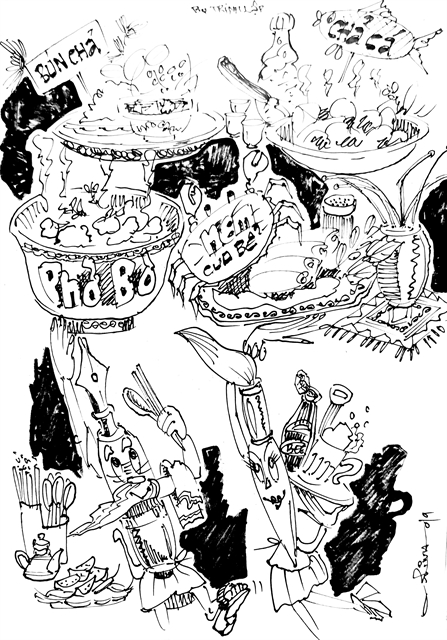 Talk Around Town
Talk Around Town

With inspiration from cuisine, many writers have published short stories, itineraries, poems and cartoons.

|
| Illustration by Trịnh Lập |
By Đỗ Hữu
Mai Ly spends her weekends reading books on gastronomy written by Di Li. It’s a long time since when she's been so passionate about reading.
“I used to read a little bit before bed, but the recent books by Di Li make my eyes devour the pages,” Ly says.
“Li is my favourite author with crime novels, non-fictional pieces and funny short stories in her repertoire, but this is the first time she has written about her culinary journeys. It’s more than food and cooking, the books reflect the culture, tradition and lifestyle of the people where the dishes originate.”
Last month, Li released two books containing 107 short stories. Tôi Đã Ăn Cả Cánh Đồng Hoa (I Have Eaten a Flower Field) reflects local cuisine, while Nửa Vòng Trái Đất Uống Một Ly Trà (Halfway Around the World for a Cup of Tea) tells amazing stories of global gastronomy.
Li says writing about cuisine doesn’t just mean food, specialities and recipes. Through cuisine, the author provides a “cultural code” for each region and each nation.
“When you travel to a new place, there are three things to do: sightseeing, trying local food and meeting local people. For me food plays an important role in reflecting a culture,” says Li.
“That’s why the taste of local food linger on my lips and is in my mind as much as the memories and emotions of the landscape and the people.”
“Through these stories, I want to reflect the society, culture and lifestyle of the people I visit I believe food is a wonderful bridge between peoples and cultures.”
Critic Phạm Xuân Nguyên says Li’s books marked the return of gastronomic literature.
“In the past, writings about local food in Việt Nam attracted many readers, like classic literary works,” he says.
“Gastronomic literature in the 20th century highlighted various authors like Nguyễn Tuân, Thạch Lam, Băng Sơn, Vũ Bằng and Tô Hoài. Their words described food, including the taste, how to cook it, how to enjoy it, and the emotions of the authors.”
“These works helped to transfer the culture and lifestyle of Vietnamese people and became an integral part of national literature,” says Nguyên.
Nguyên says the stories also expressed the deep love and attachment of the authors to their country.
Regretfully, gastronomic literature has been largely ignored since the end of the 20th century, but now some writers are returning to the subject.
With inspiration from cuisine, many writers have published short stories, itineraries, poems and cartoons.
“It’s a good sign that the subject is returning, and we believe gastronomic literature will flourish again,” says Nguyên.
A month ago, writer/poet Nguyễn Quang Thiều, 60, author of many books, released Mùi Của Ký Ức (Scent of the Past).
The gastronomic essays by Thiều focus on vivid memories of dishes from Chùa Village, his homeland, as a representation of the northern countryside’s culture.
“While Li’s books can be seen as a journey of a young person who goes out to discover the world, Thiều’s essays are the return of an old man who finds his way back to his roots,” says critic Nguyên.
Thiều says gastronomic literature is an inspiration and genre in many countries, yet in Việt Nam not many authors focus on this subject.
“Some writers think cuisine is something small, and it’s just about eating and drinking,” he says.
“It’s not true. For me, cuisine is the art of life, indulgence, culture, memories and many other wonderful things hidden in the food.
“In literature, no subject is smaller than another. The point is how the writers send a message through their work."
Thiều says: “It’s unfair when we have literature about the war, education, rural areas and crime, but nothing on gastronomy. Food is a bridge connecting people, a good dish reveals many things and can help many things.
“I agree with Li that food reflects the culture, tradition and history of a nation and a community. Food is useful for promoting the image of a country to the world. The fact is that cuisine is one of the main attractions for tourists in Việt Nam.”
Painter Đặng Hồng Quân, co-author of cartoons Lê La Quà Vặt (Streetfood in Hà Nội) and Ăn Quà Xuyên Việt (Streetfood Nationwide) released in 2017, appreciates the role of gastronomic literature.
“Readers are always eager to try new things, so gastronomic books can be considered a new dish in the feast,” Quân says.
“Telling stories about food through drawings is a good way to attract readers. I mention go-to destinations for street food and signature dishes that people must try when they visit different parts of the country, for example spring rolls in Hà Nội, iced coffee in HCM City and sweet dessert in Huế.”
After launching the books, Quân and co-author Trương Quý also started a Facebook page named Lê La Quà Vặt as a way to nurture their spiritual child.
“On the page, people still talk about the books and food everyday, review the signature food in places they have visited and suggest the best spots to go to,” Quân says.
“It will provide inspiration and material for me to publish more editions of Lê La Quà Vặt,” he adds. VNS




